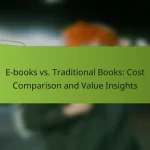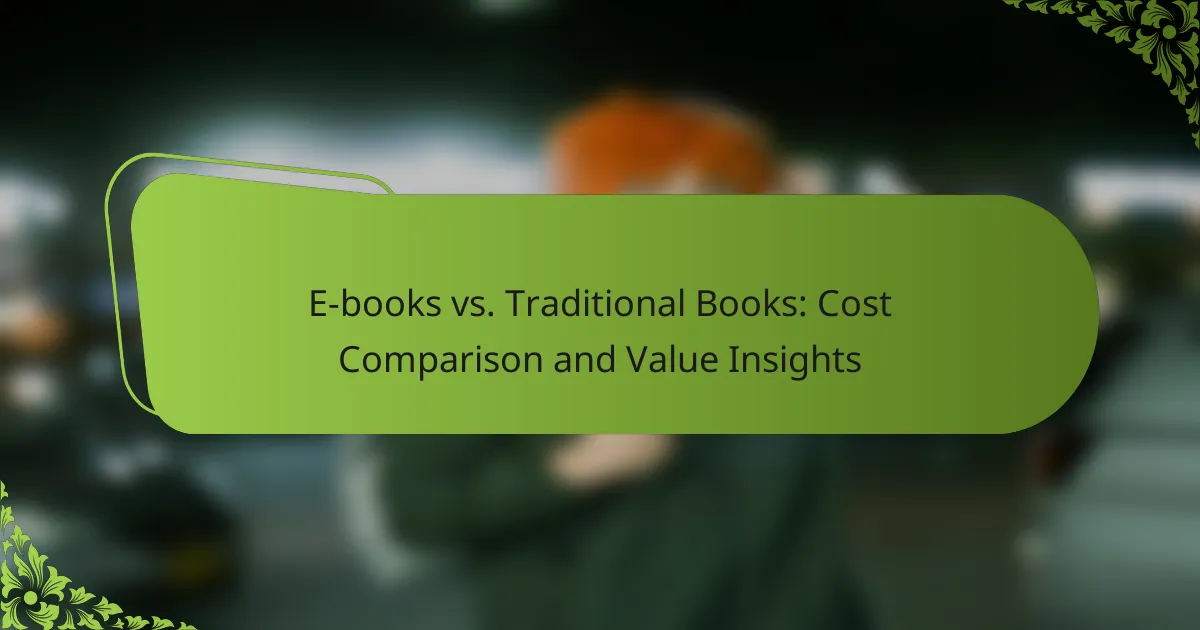The debate between e-books and traditional books often centers around cost and value. While e-books typically come at a lower price point, various factors such as format and demand can affect pricing for both formats. Additionally, e-books provide unique advantages in terms of accessibility and convenience, whereas traditional books offer a tactile experience that some readers cherish.
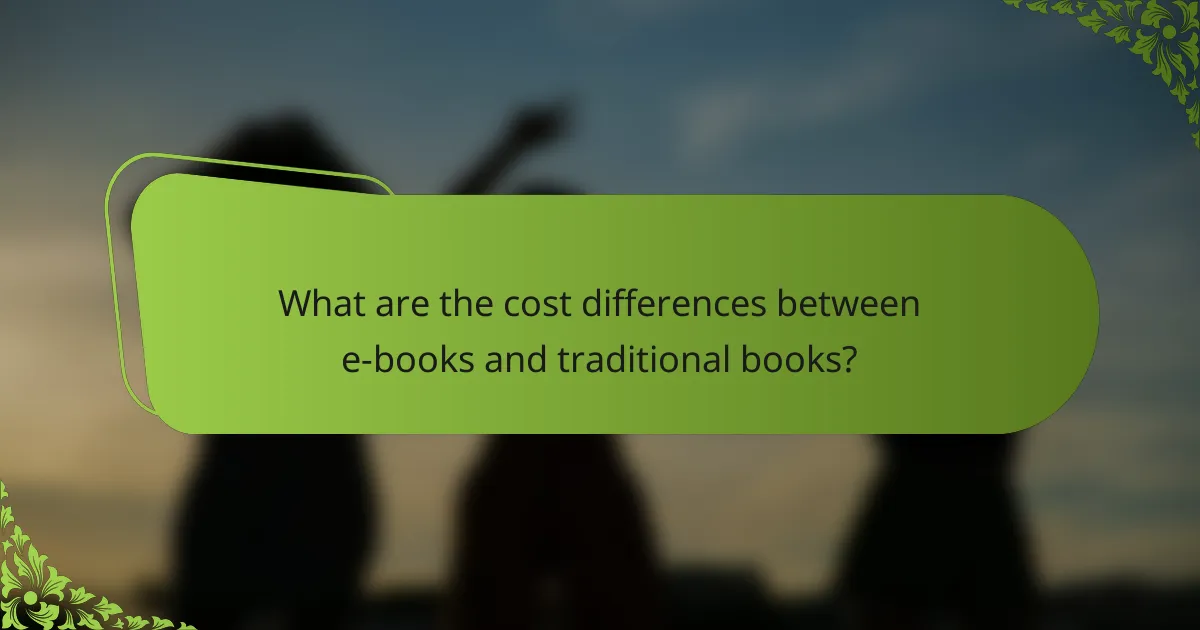
What are the cost differences between e-books and traditional books?
The cost differences between e-books and traditional books can be significant, with e-books generally being less expensive. However, factors such as format, publisher, and market demand can influence pricing for both types of books.
E-book pricing trends
E-book prices have seen a downward trend over recent years, often ranging from a few dollars to around twenty dollars for new releases. Discounts and promotions are common, especially on platforms like Amazon and Apple Books, making e-books an attractive option for budget-conscious readers.
Subscription services, such as Kindle Unlimited or Scribd, offer access to a vast library of e-books for a monthly fee, which can further reduce the overall cost for avid readers. This model allows users to explore multiple titles without the commitment of purchasing each one.
Traditional book pricing trends
Traditional book prices vary widely, typically starting from around ten dollars for paperbacks and going up to fifty dollars or more for hardcover editions. Bestsellers and new releases often command higher prices, while older titles may be available at discounted rates.
Used bookstores and online marketplaces like eBay or AbeBooks can provide significant savings on traditional books, allowing readers to find titles at lower prices. However, the condition of used books can vary, which is an important consideration when purchasing.
Average cost comparison
On average, e-books tend to be cheaper than traditional books, with e-books often priced between five to twenty dollars compared to traditional books which can range from ten to fifty dollars. This price difference can be a deciding factor for many readers when choosing between formats.
When considering long-term reading habits, e-books may offer better value due to their lower upfront costs and the availability of subscription services. However, traditional books provide a tactile experience that many readers cherish, which can justify the higher price for some.
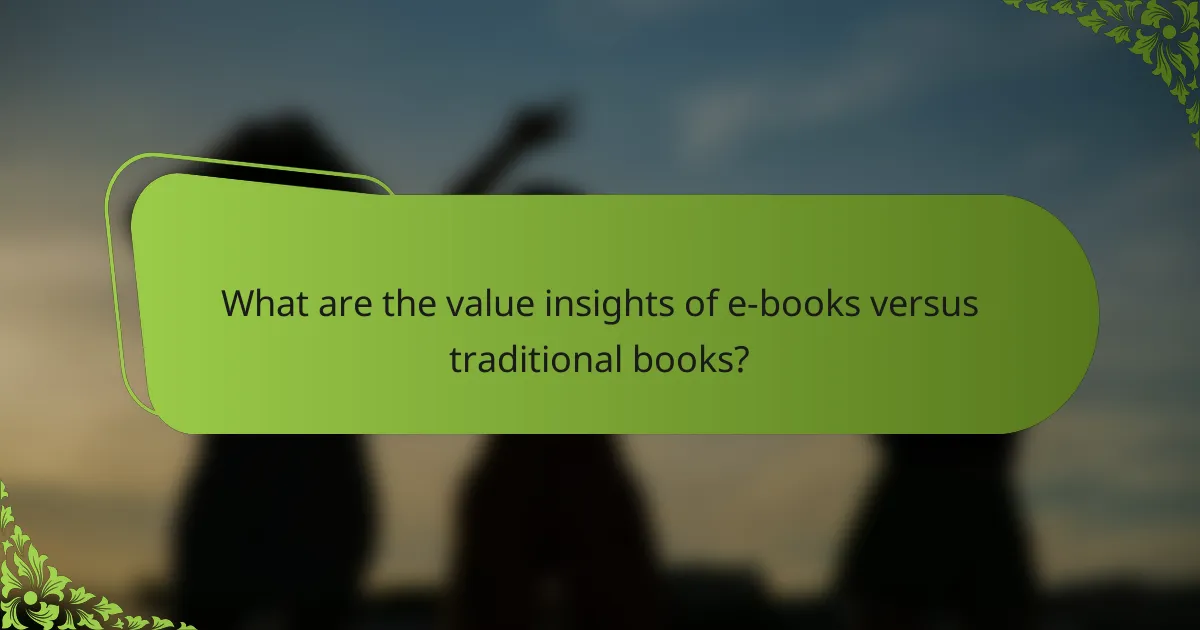
What are the value insights of e-books versus traditional books?
E-books offer a unique value proposition compared to traditional books, primarily in terms of cost, accessibility, and convenience. While traditional books provide a tangible experience, e-books can be more economical and versatile for readers.
Convenience of e-books
E-books are highly convenient, allowing readers to access a vast library instantly from their devices. They can be read on various platforms, such as tablets, e-readers, and smartphones, making it easy to carry multiple titles without physical weight.
Additionally, e-books often come with features like adjustable font sizes, built-in dictionaries, and note-taking capabilities, enhancing the reading experience. Many e-books are available at lower prices compared to their printed counterparts, especially during sales or promotions.
Physical experience of traditional books
Traditional books provide a sensory experience that e-books cannot replicate, including the feel of the pages and the smell of the paper. Many readers appreciate the tactile nature of holding a book and the satisfaction of turning physical pages.
Moreover, traditional books can serve as decorative items and can be shared easily among friends and family. For some, the experience of visiting a bookstore or library adds to the joy of reading, creating a connection to the literary community.
Longevity and durability
Traditional books are often seen as more durable, with the potential to last for decades or even centuries if properly cared for. They do not rely on technology, meaning they can be read without batteries or electronic devices.
In contrast, e-books are subject to the lifespan of the devices they are stored on, which may require updates or replacements over time. However, e-books can be easily backed up and stored in the cloud, providing a form of digital preservation that can safeguard against physical damage.

How do e-books and traditional books impact reading habits?
E-books and traditional books influence reading habits differently, affecting how often and how much people read. E-books often promote more frequent reading due to their accessibility and convenience, while traditional books can foster deeper engagement with the material.
Reading frequency with e-books
E-books typically lead to increased reading frequency as they can be accessed on various devices like tablets, smartphones, and e-readers. This convenience allows readers to carry multiple titles at once, encouraging spontaneous reading during short breaks or commutes.
Moreover, e-books often come with features such as adjustable font sizes and built-in dictionaries, which can enhance the reading experience. Readers may find themselves reading more often, as they can easily switch between genres and titles without the need for physical space.
Reading frequency with traditional books
Traditional books may encourage a more focused reading experience, as they require dedicated time and space. Many readers appreciate the tactile nature of physical books, which can lead to longer, uninterrupted reading sessions. This deep engagement can enhance comprehension and retention of the material.
However, the physical limitations of traditional books, such as weight and storage, can restrict how many titles a reader engages with at one time. As a result, some readers may find themselves reading less frequently compared to their e-book counterparts, particularly if they have busy lifestyles.
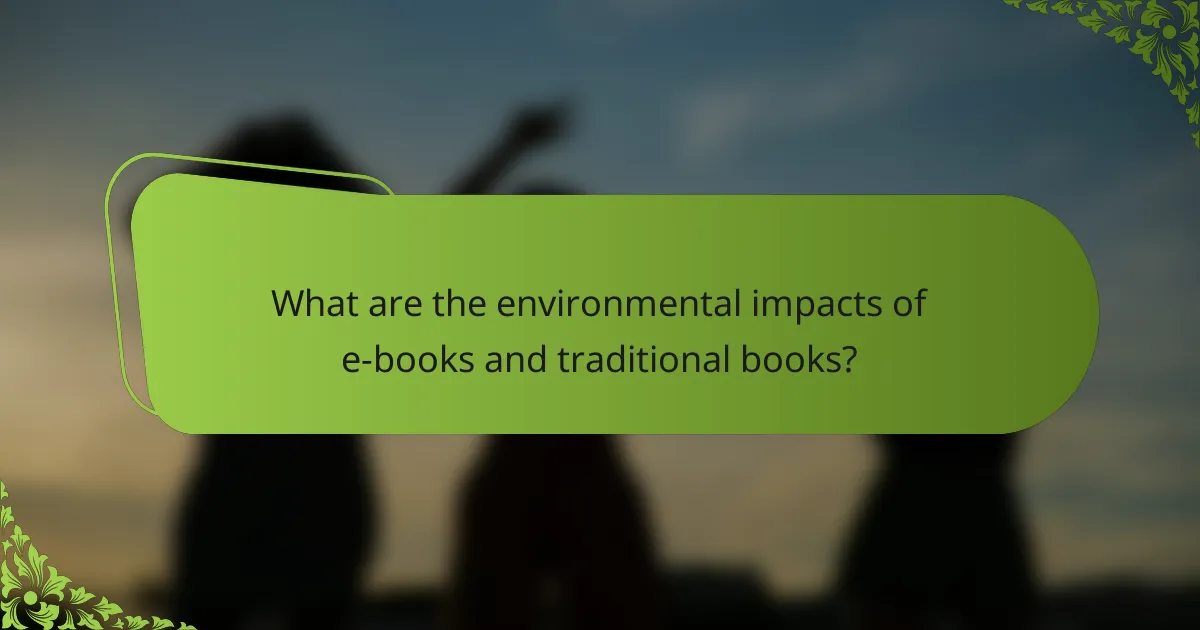
What are the environmental impacts of e-books and traditional books?
The environmental impacts of e-books and traditional books vary significantly, primarily due to their production, distribution, and consumption processes. While e-books reduce paper use, they require electronic devices that have their own environmental costs, including energy consumption and electronic waste.
Carbon footprint of e-books
The carbon footprint of e-books largely stems from the manufacturing and energy consumption of electronic devices such as e-readers, tablets, and smartphones. The production of these devices involves mining for metals and manufacturing processes that emit greenhouse gases. Additionally, e-books require electricity for downloading and reading, which can contribute to carbon emissions depending on the energy source.
On average, the carbon footprint of reading an e-book can range from a few grams to several hundred grams of CO2, depending on the device used and its energy efficiency. Using energy-efficient devices and renewable energy sources can help mitigate these impacts.
Carbon footprint of traditional books
Traditional books have a carbon footprint primarily associated with paper production, printing, and transportation. The process of producing paper involves deforestation, water usage, and energy consumption, all of which contribute to carbon emissions. Additionally, transporting books from publishers to retailers adds further emissions.
The carbon footprint of a single traditional book can vary widely, often falling between 1 to 3 kilograms of CO2, depending on factors such as the type of paper used and the distance traveled. Choosing books printed on recycled paper or supporting local publishers can help reduce this footprint.

What factors should you consider when choosing between e-books and traditional books?
When choosing between e-books and traditional books, consider factors such as storage, portability, access to titles, and overall value. Each format has unique advantages that can influence your reading experience and budget.
Storage and portability
E-books are highly portable, allowing you to store hundreds of titles on a single device, such as a tablet or e-reader. This eliminates the need for physical space and makes it easy to carry your entire library wherever you go.
In contrast, traditional books require physical space and can be cumbersome to transport, especially if you enjoy reading multiple titles at once. If you frequently travel or commute, e-books may offer a significant advantage in terms of convenience.
Access to titles and availability
E-books provide immediate access to a vast selection of titles through online platforms, often at lower prices than their physical counterparts. Many e-book retailers offer promotions and discounts, making it easier to find deals.
Traditional books may have limited availability, especially for niche genres or older titles. While local bookstores and libraries are valuable resources, they may not always stock the specific book you want, requiring additional time and effort to obtain it.

What are the emerging trends in the book industry?
The book industry is increasingly shifting towards digital formats, driven by technological advancements and changing consumer preferences. Key trends include the rise of digital reading platforms and the integration of multimedia elements into e-books, enhancing the reading experience.
Growth of digital reading platforms
Digital reading platforms have seen significant growth, providing readers with easy access to a vast library of e-books. Services like Kindle, Apple Books, and Google Play Books offer subscription models, allowing users to read multiple titles for a monthly fee, often ranging from $10 to $15.
These platforms also facilitate features such as adjustable font sizes, background colors, and note-taking capabilities, which enhance user experience. As more readers embrace digital formats, traditional publishers are increasingly adapting their offerings to include e-book versions alongside print editions.
Integration of multimedia in e-books
Multimedia integration in e-books is becoming a standard feature, allowing authors to enrich their narratives with audio, video, and interactive elements. This trend is particularly popular in educational materials, where videos can illustrate complex concepts and quizzes can reinforce learning.
For instance, textbooks may now include embedded videos that explain difficult topics, making learning more engaging. However, while these features add value, they can also increase production costs and may require more advanced devices for optimal viewing, which could be a consideration for some readers.



